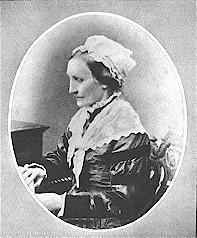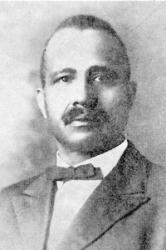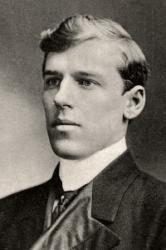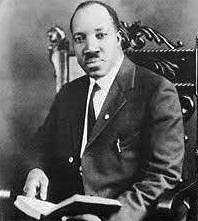Planning worship?
Check out our sister site, ZeteoSearch.org,
for 20+ additional resources related to your search.
- |
User Links
Person Results
I. B. Woodbury
1819 - 1858 Topics: Devotional or Worship Composer of "[When I survey the wondrous cross]" in Assembly Songs Woodbury, Isaac Baker. (Beverly, Massachusetts, October 23, 1819--October 26, 1858, Columbia, South Carolina). Music editor. As a boy, he studied music in nearby Boston, then spent his nineteenth year in further study in London and Paris.
He taught for six years in Boston, traveling throughout New England with the Bay State Glee Club. He later lived at Bellow Falls, Vermont, where he organized the New Hampshire and Vermont Musical Association. In 1849 he settled in New York City where he directed the music at the Rutgers Street Church until ill-health caused him to resign in 1851. He became editor of the New York Musical Review and made another trip to Europe in 1852 to collect material for the magazine. in the fall of 1858 his health broke down from overwork and he went south hoping to regain his strength, but died three days after reaching Columbia, South Carolina.
He published a number of tune-books, of which the Dulcimer, of New York Collection of Sacred Music, went through a number of editions. His Elements of Musical Composition, 1844, was later issued as the Self-instructor in Musical Composition. He also assisted in the compilation of the Methodist Hymn Book of 1857.
--Leonard Ellinwood, DNAH Archives
I. B. Woodbury
Mrs. Catherine J. Bonar

1821 - 1884 Topics: Devotional or Worship Author of "Fade, Fade Each Earthly Joy!" in Songs of Praise Bonar, Jane Catharine, née Lundie, daughter of the Rev. Robert Lundie, some time minister of the parish of Kelso, born at Kelso Manse, December, 1821, married, in 1843, to Dr. H. Bonar, and died in Edinburgh, Dec. 3, 1884. Her hymns appeared in Dr. Bonar's Songs for the Wilderness, 1843-4, and his Bible Hymn Book, 1845. Their use is very limited. Mrs. Bonar is chiefly known through her hymn:—
Pass away, earthly joy. Jesus, all in all, which appeared in the Songs for the Wilderness, 2nd Series, 1844, and again in the Bible Hymn Book, 1845, No. 108, in 4 stanzas of 8 lines, including the refrain, "Jesus is mine!" The original text is given in Dr. Hatfield's Church Hymn Book. 1372, No. 661. Sometimes this is altered to "Fade, fade, each earthly joy," as in the American Songs for the Sanctuary, 1865, No. 114, and others. The last stanza of this hymn is also st. iv. of the cento, "Now I have found a friend," &c. (q. v.)
-- John Julian, Dictionary of Hymnology (1907)
Mrs. Catherine J. Bonar
Charles Price Jones

1865 - 1949 Person Name: C. P. J. Topics: Devotional or Worship Author of "Deeper, Deeper" in Songs of Praise Charles Price Jones born December 9, 1865, near Rome, Georgia. He grew up in Kingston, Georgia, and attended the Baptist church. He was converted in 1884 while living in Cat Island, Arkansas. In 1885 he was called to the ministry and began preaching. In 1888 he attended Arkansas Baptist College and taught school in Grant County, Arkansas. He preached and pastored several Baptist churches. After asking God for a deeper experience of grace and fasting and praying for three days, Jones experienced a closeness with God, and in 1895, along with other Baptist holiness adherents, who taught that a second work of grace can cleanse the Christian of original sin. They started a holiness movement in the Baptist church, and he began teaching holiness in his congregation, Mount Helm Baptist Church in Jackson, Mississippi. He faced much opposition from some members of his congregation and other Baptist churches. Eventually the church voted to remove "Baptist" and change it to "Church of Christ." For several years, Jones led a non-denominational holiness movement. In 1899 he began to write songs for his church. Most of his hymns were inspired by a scripture passage. The congregation built the Christ Temple campus which included a 1000 seat sanctuary, a printing press, a school building, and a girl's dormitory. In 1917, Jones organized Christ Temple Church in Los Angeles and moved the printing press there. He died January 19, 1949 in Los Angeles
Dianne Shapiro, from Church of Christ (Holiness) U.S.A. website and "Charles Price Jones (1865-1949) Religious Leader" by David Daniels, Mississippi Encyclopedia website (both accessed 10/9/2020)
Charles Price Jones
Thoro Harris

1874 - 1955 Person Name: T. H. Topics: Devotional or Worship Author of "All That Thrills My Soul" in Assembly Songs Born: March 31, 1874, Washington, DC.
Died: March 27, 1955, Eureka Springs, Arkansas.
Buried: International Order of Odd Fellows Cemetery, Eureka Springs, Arkansas.
After attending college in Battle Creek, Michigan, Harris produced his first hymnal in Boston, Massachusetts, in 1902. He then moved to Chicago, Illinois at the invitation of Peter Bilhorn, and in 1932, to Eureka Springs, Arkansas. He composed and compiled a number of works, and was well known locally as he walked around with a canvas bag full of handbooks for sale. His works include:
Light and Life Songs, with William Olmstead & William Kirkpatrick (Chicago, Illinois: S. K. J. Chesbro, 1904)
Little Branches, with George J. Meyer & Howard E. Smith (Chicago, Illinois: Meyer & Brother, 1906)
Best Temperance Songs (Chicago, Illinois: The Glad Tidings Publishing Company, 1913) (music editor)
Hymns of Hope (Chicago, Illinois: Thoro Harris, undated, circa 1922)
--www.hymntime.com/tch
Thoro Harris
E. E. Hewitt

1851 - 1920 Topics: Devotional or Worship Author of "O for a Heart Whiter Than Snow" in Assembly Songs Pseudonym: Lidie H. Edmunds.
Eliza Edmunds Hewitt was born in Philadelphia 28 June 1851. She was educated in the public schools and after graduation from high school became a teacher. However, she developed a spinal malady which cut short her career and made her a shut-in for many years. During her convalescence, she studied English literature. She felt a need to be useful to her church and began writing poems for the primary department. she went on to teach Sunday school, take an active part in the Philadelphia Elementary Union and become Superintendent of the primary department of Calvin Presbyterian Church.
Dianne Shapiro, from "The Singers and Their Songs: sketches of living gospel hymn writers" by Charles Hutchinson Gabriel (Chicago: The Rodeheaver Company, 1916)
E. E. Hewitt
Mrs. C. H. Morris

1862 - 1929 Person Name: Mrs. C. H. M. Topics: Devotional or Worship Author of "Have Ye Received the Holy Ghost?" in Assembly Songs Lelia (Mrs. C.H.) Morris (1862-1929) was born in Pennsville, Morgan County, Ohio. When her family moved to Malta on the Muskingum River she and her sister and mother had a millinery shop in McConnelsville. She and her husband Charles H. Morris were active in the Methodist Episcopal Church and at the camp meetings in Sebring and Mt. Vernon. She wrote hymns as she did her housework. Although she became blind at age 52 she continued to write hymns on a 28-foot long blackboard that her family had built for her. She is said to have written 1000 texts and many tunes including "Sweeter as the years go by."
Mary Louise VanDyke
Mrs. C. H. Morris
George Keith
1638 - 1716 Topics: Devotional or Worship Author of "How Firm a Foundation" in Assembly Songs George Keith, according to D. Sedgwick, was the author of "How firm a foundation, ye saints of the Lord." Little is known about Keith, save that he was a publisher, a son-in-law of Dr. Gill, and the composer of several hymns.
--Annotations of the Hymnal, Charles Hutchins, M.A. 1872.
George Keith
Robert Harkness

1880 - 1961 Topics: Devotional or Worship Composer of "[That God should love a inner such as I]" in Assembly Songs After attending a revival meeting by Reuben Torrey and Charles M. Alexander, Harkness became Alexander’s pianist. He came to Christ shortly thereafter (on a bicycle, he said), and made several round the world tours with Torrey and Alexander.
Harkness was especially well known for his program The Music of the Cross, and as the author of correspondence courses in hymn playing. He wrote over 2,000 hymns and Gospel songs in his lifetime.
(hymntime.com/tch)
Robert Harkness
G. T. Haywood

1880 - 1931 Person Name: G. T. H. Topics: Devotional or Worship Author of "Jesus the Son of God" in Assembly Songs Garfield Thomas Haywood (July 15, 1880 – April 12, 1931) was an African-American pastor and song writer who served as Presiding Bishop of the Pentecostal Assemblies of the World from 1925 to 1931.
Haywood was born to Bennett and Pennyann Haywood in Greencastle,Indiana, in 1880 and moved to Haughville, a neighborhood in Indianapolis, at the age of three. As a child, he attended School 52 and then Shortridge High School. Haywood was employed by the Indianapolis Freeman and Indianapolis Recorder news papers as a cartoonist.
In 1909, Haywood founded Christ Temple church. Haywood's influence crossed ethnic boundaries; by 1913, Christ Temple had a bi-racial membership of 400 to 500 and later grew to 1500. Around 1915, Haywood received a copy of Frank Ewart's paper Meat in Due Season which argued for Jesus' Name doctrine. In response, Haywood invited the evangelist Glenn A. Cook to preach at Christ Temple, resulting in Haywood and his congregation converting to Oneness Pentecostalism and facilitating the spread of Oneness Pentecostalism throughout Indiana.
The third general council of the Assemblies of God convened in October 1915 on the agenda was a debate on the merits of the new Jesus'-name doctrine vs the traditional trinitarian doctrine. Haywood and E. N. Bell spoke on behalf of the Jesus' Name doctrine and Collins and Jacob Miller spoke against. The result was a draw and it was agreed to readdress the topic at the fourth general council in October 1916. At the fourth general council a statement of faith was enacted which soundly rejected Jesus'-name doctrine causing just over one fourth of the ministers including Haywood to leave the Assembles of God. In 1911 Haywood had become affiliated with the Pentecostal Assemblies of the World (PAW) and after his conversion helped convert the origination to Oneness Pentecostalism. Many of the former Assemblies of God ministers that left in 1916 formed the General Assembly of the Apostolic Assemblies which at the start of WWI merged with the PAW in order for its minsters to obtain noncombatant statues. The new and interracial organization appointed Haywood as its general chairman. By 1924 the PAW split on racial lines due to logistical and social problems created by Jim Crow laws and Haywood was appointed Bishop of the newly reorganized PAW.
Haywood composed many gospel songs including "Jesus, the Son of God", "I See a Crimson Stream of Blood", and "Do All in Jesus’ Name". Many of his songs were published in The Bridegroom Songs, which was published by Christ Temple. His songs are known for Oneness Pentecostal themes. Haywood was also an author and Oneness apologist. He wrote tracts, such as "The Victim of the Flaming Sword" and "The Finest of Wheat" as well as published Garfield Thomas Haywood (July 15, 1880 – April 12, 1931) was an African-American pastor and song writer who served as Presiding Bishop of the Pentecostal Assemblies of the World from 1925 to 1931.
Haywood was born to Bennett and Pennyann Haywood in Greencastle,Indiana, in 1880 and moved to Haughville, a neighborhood in Indianapolis, at the age of three. As a child, he attended School 52 and then Shortridge High School. Haywood was employed by the Indianapolis Freeman and Indianapolis Recorder news papers as a cartoonist.
In 1909, Haywood founded Christ Temple church. Haywood's influence crossed ethnic boundaries; by 1913, Christ Temple had a bi-racial membership of 400 to 500 and later grew to 1500. Around 1915, Haywood received a copy of Frank Ewart's paper Meat in Due Season which argued for Jesus' Name doctrine. In response, Haywood invited the evangelist Glenn A. Cook to preach at Christ Temple, resulting in Haywood and his congregation converting to Oneness Pentecostalism and facilitating the spread of Oneness Pentecostalism throughout Indiana.
The third general council of the Assemblies of God convened in October 1915 on the agenda was a debate on the merits of the new Jesus'-name doctrine vs the traditional trinitarian doctrine. Haywood and E. N. Bell spoke on behalf of the Jesus' Name doctrine and Collins and Jacob Miller spoke against. The result was a draw and it was agreed to readdress the topic at the fourth general council in October 1916. At the fourth general council a statement of faith was enacted which soundly rejected Jesus'-name doctrine causing just over one fourth of the ministers including Haywood to leave the Assembles of God. In 1911 Haywood had become affiliated with the Pentecostal Assemblies of the World (PAW) and after his conversion helped convert the origination to Oneness Pentecostalism. Many of the former Assemblies of God ministers that left in 1916 formed the General Assembly of the Apostolic Assemblies which at the start of WWI merged with the PAW in order for its minsters to obtain noncombatant statues. The new and interracial organization appointed Haywood as its general chairman. By 1924 the PAW split on racial lines due to logistical and social problems created by Jim Crow laws and Haywood was appointed Bishop of the newly reorganized PAW.
Haywood composed many gospel songs including "Jesus, the Son of God", "I See a Crimson Stream of Blood", and "Do All in Jesus’ Name". Many of his songs were published in The Bridegroom Songs, which was published by Christ Temple. His songs are known for Oneness Pentecostal themes. Haywood was also an author and Oneness apologist. He wrote tracts, such as "The Victim of the Flaming Sword" and "The Finest of Wheat" as well as published The Voice in the Wilderness, a publication that became the official organ of the Pentecostal Assemblies of the World in 1925.
After his death in 1931, Haywood was buried in Crown Hill Cemetery, and in 1980, the city of Indianapolis renamed the segment of Fall Creek Drive where Christ Temple is located Bishop Garfield T. Haywood Memorial Way. The Voice in the Wilderness, a publication that became the official organ of the Pentecostal Assemblies of the World in 1925.
After his death in 1931, Haywood was buried in Crown Hill Cemetery, and in 1980, the city of Indianapolis renamed the segment of Fall Creek Drive where Christ Temple is located Bishop Garfield T. Haywood Memorial Way.
--en.wikipedia.org/wiki
G. T. Haywood
Haldor Lillenas

1885 - 1959 Person Name: H. L. Topics: Devotional or Worship Author of "The Garden of My Heart" in Assembly Songs Rv Haldor Lillenas DMus Norway/USA 1885-1959. Born at Stord, near Bergen, Norway, his father sold their 15 acre farm in Norway and emigrated to the U.S., buying a farm in Colton, SD. After he built a sod house, the family (wife and three chldren) also came to SD in 1887. They moved to Astoria, Oregon in 1889, where Lillenas learned English and began writing song lyrics at an early age. In 1900 the family moved again to Roseville, MN, where he worked as a farm laborer and began attending a Lutheran high school at Hawick, MN. He sold a few songs at age 19. At age 21 he began writing more songs, encouraged by some earlier ones becoming popular (“He set me free” was one). His mother died in 1906 and his father returned to ND, but Lillenas decided to move back to Astoria, OR, to finish a chemical correspondence course he had been taking. There he found employment in a chemical factory. He started attending a Lutheran church, but one evening he heard the song, “Tell mother I’ll be there”, sung at a mission. It made him decide to commit his life to Christ. An elderly lady who worked there told him about Jesus, and he began attending the Peniel Mission, a holiness rescue mission in Astoria, OR. He started working at the mission himself. In 1907 he moved to Portland, OR, where he worked with the Peniel Mission there, the mission paying most of his expenses. He was appointed leader of the mission. He saw many there come to know Christ and felt called to the Lord’s work. He joined the First Church of the Nazarene in Portland. Soon he enrolled in a ministerial course of study by correspondence. Soon afterward, he joined a vocal group associated with the Salvation Army called the ‘Charioteers Brigade’, which held street meetings and revival services throught much of CA. As a result of generous donations made, and efforts by his pastor, A O Hendricks, he was able to attend Pacific Bible College (later renamed Pasadena College), Los Angeles, CA. He also found part-time work to help support himself. He was soon a music director at a local church, and was preaching and writing songs. He also studied voice at the Lyric School of Music in Los Angeles, CA. While at Deets, he met and married Bertha Mae Wilson, also on an evangelistic team. Both preached. She was a songwriter like he. They practiced music at her father’s house and found that their voices blended well. They had two children: Evangline, and Wendell. They eventually became elders in the Nazarene Church, and she eventually became an ordained minister as well. He also studied music at the Siegel-Myers School of Music Chicago, IL. He composed songs for cantatas, Christmas, Easter, and special day services. He also used several pseudonyms in their composition. He traveled as an evangelist, then he pastored several churches (1910-1924) at Lompoc, CA, then Redlands, CA, and later in Indianapolis, IN. While there, In 1924, he founded the Lillenas Music Company (bought by the Nazarene Publishing Company in 1930). His wife preached at their pastorate until he was able to get the company up and running. While they owned the company, they published more than 700,000 hymnals. He worked as an editor there (after selling his company) until his retirement in 1950, becoming an advisor for them until his death. Also that year Lillenas purchased a 500 acre rural estate in Miller County, MO, where they built an Ozark home called ‘Melody Lane’. Lillenas joined the American Society of Composers, Authors, and Publishers (ASCAP) in 1938. In 1941 he received an honorable doctorate degree from Olivet Nazarene College, Bourbonnais, IL. In 1945 Bertha died of cancer, and later that year Lillenas remarried to a Lola Dell, and they lived in Melody Lane until 1955, when they moved to Pasadena, CA, attending the Nazarene Church there. They also made three trips to Norway after his retirement, and he wrote three books during that time: “Modern gospel song stories (1952), “Down Melody Lane (an autobiography): (1953), “Motoring 11,000 miles through Norway-A guide for tourists” (1955). In 1955 they toured Israel and sponsored a Palestinian Greek Orthodox family he had met as immigrants to the US that included Sirhan Bishara Sirhan (born in 1944). After they arrived in Pasadena, the Sirhan family stayed with Lillenas for several months, after which the Sirhans moved to a home Lillenas rented and furnished to them. When Mary Sirhan’s husband abandoned her and her two sons and returned to Jordan, Lillenas ensured that they were able to remain in the US. S B Sirhan was the convicted killer of Robert Kennedy. Lillenas wrote some 4000 hymn lyrics, supplying some for evangelists. Four of his song books contain his hymns: “Special sacred songs” (1919), “New Sacred Songs”, “Strains of love”, and “Special sacred songs #2”. He died at Aspen, CO. He is buried at Kansas City, MO. He was an author, editor, compiler, composer, and contributor. He edited and compiled over 50 song books.
John Perry
Haldor Lillenas


 My Starred Hymns
My Starred Hymns


